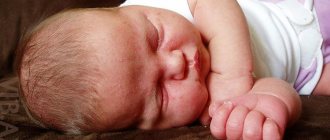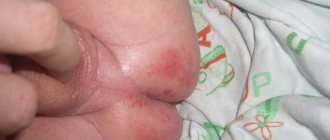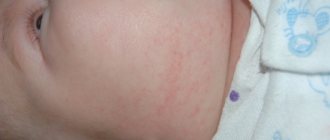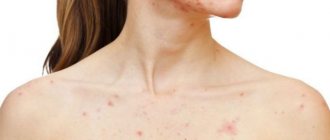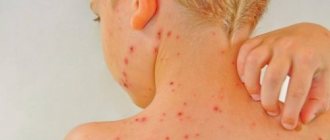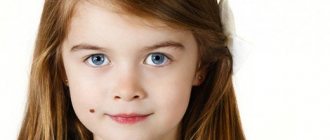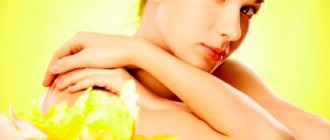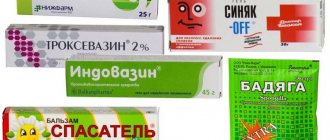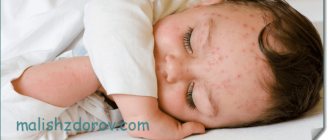Dry spots on a child’s body appear quite often, because children’s skin is very sensitive. Parents should know that the reason for the appearance of such spots may be, first of all, physiological - in young children the glands that produce sebum are partially functioning.
In addition, the condition of children's skin depends on environmental factors - water hardness and temperature, air humidity. But if red, dry spots on your child’s skin do not go away, you should consult a doctor, as they can appear due to serious illnesses.
Skin diseases are quite difficult to deal with, but a timely diagnosis will make the task easier. If a child has spots, it is very important to eliminate the cause of their occurrence in time, otherwise the disease will become chronic. Today we will talk about the possible reasons for the appearance of red, dry spots in a child, and we will tell you how to get rid of the rash.
Causes of seborrheic rash in breastfed children
The appearance of a rash on certain parts of the body (forehead, face, head, groin, back, chest) is a consequence of inflammation of the child’s skin due to the “increased work” of the sebaceous glands, which is associated with the formation and maturation of the skin, which performs the protective function of the body. This disease is called seborrheic dermatitis. Excessive activity of the sebaceous glands contributes to the increased development of yeast-like fungi, which leads to inflammation of the skin at the sites of their colonization. Infants develop a collection of greasy scales on the scalp, similar to dandruff. On areas of the body without hair (limbs, folds, chest, neck) - a spotted, red rash, with red scales around the perimeter. After a certain time, the functioning of the sebaceous glands of babies returns to normal, the inflammation stops.
An important factor in the occurrence of seborrheic dermatitis in babies is a disorder at the hormonal level: maternal hormones remaining in the child after birth activate the functional functioning of the sebaceous glands. This favors the formation of fatty crusts with a yellow tint on the baby’s head, face, and body folds, in which yeast fungus develops, causing inflammation of the skin.
The ability of the mother’s body to transmit its signs and characteristics to the child can provoke the appearance of seborrheic dermatitis in the newborn. The predisposition of parents or one of them to such a disease is inherited.
Causes of allergies on the elbows
There are many different forms of allergies, which means that the symptoms of a given disease will be different for each person.
The allergy may appear as red spots on the elbows and forearms that do not appear on other parts of the body.
It is worth noting that most cosmetics recommend testing before using their products. To do this, they advise applying a small amount of the product directly to the bend of the elbow. This location was chosen for a reason: the skin here is very thin and sensitive to allergens. This fact may explain such a selective localization of the allergic reaction.
It is important to distinguish between allergies on the inside and outside of the elbow:
- The contact reaction most often occurs inside, on the bend of the elbow (precisely for the reasons mentioned above).
- On the outside, the body’s response to food allergens usually manifests itself. One of the most common options is the appearance of blisters like urticaria.
Cleanliness of the skin characterizes the internal state of health. Often people immediately pay attention to acne that appears on the face, but minor rashes on the elbows or knees can go unnoticed for a long time. After a while, when the rash begins to itch and cause trouble, the person seeks help from a doctor.
The skin on the elbows and knees has virtually no sebaceous glands, so due to the lack of natural moisture, the skin in these places is very dry. Lack of special care and non-compliance with hygiene measures over time lead to the formation of microdamages - dry skin areas crack and become “entry gates” for various infections.
We suggest you read White lumps in the stool of a breastfeeding baby: causes of white stool
A rash on the elbows of a child or adult can be a manifestation of many unpleasant diseases that must be correctly diagnosed in time. The origin of the rash can be of a different nature (allergic, infectious, viral) - it is important to pay attention to this symptom in a timely manner so as not to trigger the underlying disease.
At the beginning of the disease, the rashes may not bother you, so the person does not pay attention to them. Over time, an unpleasant itching appears, intensifying at night. The skin on the affected areas becomes rough, begins to peel, peel off, and becomes covered with a light film or dried crusts. The size of the rashes ranges from tiny bubbles to large conglomerates, when several small red dots merge into common shapes.
Causes of seborrheic dermatitis in children over 1 year of age
At this age, the main causative agent of seborrheic dermatitis is a microorganism - a yeast-like fungus that lives on the skin of every person, often on the head. Activating the production of sebaceous glands helps improve the nutrient medium for the fungus and its reproduction. A sharp increase in the number of microorganisms on the scalp increases the number of dead particles of the upper layer of the skin, which form scales - dandruff.
A child’s fragile immune system causes a decrease in the protective function of the skin, failure to maintain personal hygiene, insufficient intake of vitamins into the child’s body, and abuse of antibiotics for treating other diseases lead to disruption of the sebaceous glands and the development of inflammation of the skin and seborrheic dermatitis. Read more about which vitamins are missing in seborrheic dermatitis in the article.
Crusts on the skin of the feet of infants
Hello! The most common allergen in childhood is cow's milk. This is exactly what you use - albeit diluted (the calorie content is reduced, but foreign proteins still remain). Who advised you to quit breastfeeding? In general, children on IV are prescribed special hypoallergenic formulas instead of breast milk. They come with varying degrees of protein purification and breakdown. Hypoallergenic mixtures with partially (moderately) hydrolyzed milk protein (“NAN GA 2”, “Nutrilon GA 2”) are intended only for the prevention of allergic diseases in children. "Damil Pepti", "Nutrilak GA", "HiPP GA 2", "Humana GA 2", allow them to be used not only for preventive purposes, but also for the treatment of mild forms of allergy to cow's milk proteins. Finally, in case of severe manifestations of allergies, you will have to either use soy mixtures (but they are not recommended to be used for a long time - 2-3 months maximum; besides, they often themselves cause allergies), goat milk mixtures (“Nenny”) - or most often prescribed hydrolyzate mixtures in which cow's milk protein is subjected to very deep breakdown into amino acids. But these mixtures are expensive, bitter (and therefore many children do not like them very much) and give the stool an unusual color and smell. Hydrolyzate mixtures include: with split casein “Nutramigen”, “Pregestimil”, “Frisopep AS”; with split whey protein “Damil Pepti”, “Nutrilak GA”, “Nutrilak Peptidi SCT”, “Nutrilon Pepti TSC”, “Alfare”, “Frisopep”. In your case, it seems to me that mixtures of the first group can help. Sometimes improvement occurs even with Nutrilon Comfort or fermented milk mixtures. If the baby categorically refuses the last of these mixtures, you can try replacing cow’s milk with at least 1-2 days of fresh kefir with 5% sugar syrup and adding the dietary supplement “Lactazar”. Of course, the girl has an allergic mood in her body and an allergic reaction to something, some allergen. We must try to identify it. Maybe it all really started with your consumption of an obligate allergen in the form of tangerines and chocolate. But now the allergen is clearly different. Most often, babies have food allergies, so you need to start with a food diary (they remove all complementary foods for several days, try to achieve maximum cleansing of the skin, then introduce them one at a time - and see the reaction). Such children are prescribed enterosgel orally, and sometimes antihistamines such as Zyrtec or Erius. Locally, it is recommended to lubricate the cheeks once a day with 0.1-1% hydrocortisone ointment (then the course can be 7 days) or Advantan, Lokoid, Afloderm (then the course is short, 5 days) + moisturizing several times a day , wound-healing emollient creams. Next, Elidel+ creams from the “Emoleum” series are prescribed for a monthly course (just remember that when using Elidel you need to avoid exposing the child to the sun). Children with allergies are recommended to bathe in water with the addition of a series infusion. I'm afraid that what I've written will seem too complicated to you. I would not describe the usual treatment regimens in such detail - but dragging a baby along a highway for 4 hours is really difficult... I will be glad if you can understand the information provided and they will help you.
Features of the disease in adolescents
Adolescence is special. The hormonal system of a young body changes. An unstable psycho-emotional state contributes to experiences and the occurrence of stressful situations. Violation of the regime, balance and calorie intake also causes activation of the sebaceous glands. That is why in adolescence there is a spread of acne on the face, peeling of the skin, and the appearance of dandruff. In addition, the appearance of seborrhea is influenced by:
- Failures in the functioning of the digestive organs due to a decrease in beneficial microflora in the intestines and an increase in harmful ones, which leads to disruption of metabolic processes at the cellular level, unbalances the work of secretion production by all glands, including the sebaceous ones;
- Activation of the sebaceous glands leads to an increase in the production of subcutaneous sebum and the abundant development of yeast-like fungi, the appearance of dandruff;
- The lack of vitamins A and E in a young body contributes to the disruption of the sebaceous glands in performing their functions in the direction of increasing secretion production;
- The wrong choice of shampoo, creams (especially foundations that close pores on the skin of the face), abuse of alcohol-containing cosmetics harm the skin, provoke the appearance of dandruff and acne;
- Neglecting hats in cold weather or prolonged exposure to the sun in the summer heat has a detrimental effect on the condition of the skin and the development of seborrheic dermatitis.
Like adults, children of all age groups suffer from seborrheic dermatitis of dry, oily and mixed types. In schoolchildren and adolescents, the oily type of seborrhea is more common, it is chronic, and after a year it is dry.
Based on the above, traditional medicine recommends that at the first sign of seborrheic dermatitis in a child of any age, use a qualified consultation in a medical institution.
Features of treatment of seborrheic dermatitis in children
Self-treatment of seborrhea in children of any age does not always bring the expected result, since the signs of different dermatitis may be the same, but the treatment methods may be different.
On the baby's head
It is necessary to note the importance of child care in the first days and months of a child’s life. Regular water procedures, ventilation of the child’s room and air exercise, proper personal hygiene products are the key to the baby’s health. An important factor is the way a nursing mother eats and takes certain medications.
The first “bell” of seborrheic dermatitis is always the appearance of dandruff, small “foci” of flaky “milky crusts” on the child’s head, and their redness.
In this case, it is best to pay attention to the child’s hygiene: bathing, combing out loose crusts with a soft brush, removing loose scales with tweezers. To wash the baby's head, you can use special shampoos for infants. After water procedures for washing the baby’s head, you can use olive or special fortified baby oil, which the pediatrician will recommend. In some cases, the doctor attributes the use of antifungal children's ointments.
On the face of a baby
Often the rash spreads from the head, covered with hair, to the face and body of the little man. In this case, the child must be provided with bathing with limited contact of facial skin with water. Use only detergents (gels, soaps, shampoos) that do not irritate the skin. Water procedures must be completed by wiping the child’s dry body and face with specialized products, such as cleansing, skin softening, vitamin A-enriched creams, and antifungal products.
It is forbidden to remove peeling crusts with your fingernails.
It must be remembered: a child’s body is not a place for experimentation. All medical procedures must be carried out after consultation and prescription by a doctor.
Children over 1 year old
Treatment of seborrheic dermatitis in children of preschool and school age is carried out comprehensively. With strict adherence to personal hygiene and a special diet, medications for internal and external use are used in combination with physiotherapy. The specific treatment is prescribed by the doctor, guided by the tests and studies performed.
The necessity of using external agents depends on the form of seborrheic dermatitis and the age of the patient. This category of drugs includes medicated shampoos and softening creams, ointments and various cosmetic oils, medicinal baths.
Increasing the child’s immune defense, destroying yeast-like fungus on the body and scalp, eliminating factors contributing to the disease are the main areas of use of medicines and drugs:
- Calming the nervous system as a result of experiences and stressful situations;
- Antifungal ointments;
- Probiotics to improve the functioning of the digestive system by improving intestinal microflora and enhancing immunity;
- Vitamins A, E;
- Natural or synthetic agents that have a regulating effect on the immune system of the child’s body.
The latest developments in physiotherapy improve blood circulation in the skin and increase skin tone. Carrying out massages, applying a magnet to certain areas of the body, stimulating specific points with a laser beam, in combination with medications, can speed up the child’s recovery process.
Treatment in adolescents
The process of puberty in girls and boys is strictly individual. For some girls it starts at 8-9 years old and ends at 14-15. For boys, this process begins later - from 11-13 years old and ends by 18-20.
During this period, there is an increase in the secretion of the sebaceous glands, which becomes a breeding ground for yeast-like fungus and the cause of seborrheic dermatitis of the scalp, face and other parts of the body.
Treatment of seborrheic dermatitis in adolescents is not much different from treatment in adults. But sometimes it is enough to exclude chocolate, hot spices and seasonings, and pickles from the diet, and dermatitis stops its development. But it is better to consult a dermatologist, conduct a comprehensive examination of the body, and additional tests to carry out highly effective treatment measures.
A rash on a teenager’s body is often accompanied by the appearance of acne and itchy, scaly plaques. Constant scratching can lead to secondary infection.
During this period, it is necessary to normalize metabolic processes at the cellular level and stabilize the functioning of the digestive system. At the same time, therapeutic measures are carried out to cure chronic diseases, eliminate nervous shocks and eliminate stressful situations as much as possible.
Simultaneously with drug treatment, which includes the use of antihistamines, choleretic drugs, and a complex of vitamins, auxiliary physiotherapy is carried out. It is designed to improve the effect of medications, prevent relapse, and reduce testosterone levels during puberty in a young body.
Physical therapy may include:
- Administration of drugs through the skin of a teenager;
- Special treatment of affected areas of the body with infrared rays;
- Using liquid nitrogen to treat affected areas;
- Use of electric current;
- Breathing procedures with enriched oxygen to improve the metabolic process in the body.
An important role in the treatment of seborrheic dermatitis is played by personal hygiene with special shampoos, gels, soaps, and creams.
Treatment of spots on elbows - features and recommendations
If white spots are found on a child’s elbows, which most often indicate an allergy, parents are not recommended to determine the allergen themselves. In order to prevent a mistake that could result in serious harm to the little body, it is better to show the baby to a doctor.
After identifying the irritant, it is necessary to immediately exclude it, and then begin local treatment. To relieve irritation, the doctor prescribes medications that have an antihistamine effect. The use of ointment or gel helps get rid of itching, remove peeling, and start the regeneration of affected tissues.
If spots on the elbows are caused by a fungal infection, antifungal drugs are used. Medicines are prescribed by a specialist; it is strictly forbidden to act independently - errors in treatment will lead to the spread of the fungus to healthy skin.
Serious illnesses (eczema or psoriasis) are treated only under the supervision of a specialist. You can resort to home remedies (herbal decoctions or infusions) that will serve as auxiliary therapy, but first consult with your doctor.
Prevention of seborrheic dermatitis in children
Seborrheic dermatitis is an inflammation of the skin as a result of an imbalance in the water balance of the skin and inflammatory processes. Children predisposed to dry skin and flaking need to regularly use moisturizing skin creams that form an imperceptible thin film on the surface of the skin to prevent increased evaporation of moisture from the surface of the body and restore the skin.
The course of the disease is more severe in children suffering from neurological disorders and immunodeficiency. It is these ailments that it is recommended to pay constant attention to prevent the occurrence of dermatitis.
For both infants and older children, personal hygiene plays an important role. Cleanliness of the body is the key to preventing seborrheic dermatitis. For water procedures it is better to use warm water. Hot water causes damage to the skin, which promotes infection and the development of fungi, causing disease.
Stabilizing your daily diet is one of the main measures. Food should be rich in vitamins A and E, which include seafood, nuts, and vegetable oils. Dietary low-fat meat, vegetables, berries and fruits, natural freshly prepared juices are components of a healthy diet for a child. Nursing mothers are advised to consult a pediatrician or nutritionist before eating or feeding their baby. Limited consumption of cakes, sweets, buns, sweet drinks, fried meat and fatty foods has a beneficial effect on stabilizing the metabolic process in the body.
Special requirements for children's clothing. For infants, all diapers and nappies should always be dry and clean, and diapers should be changed in a timely manner. For older children - clothing only made from natural, smooth materials that do not irritate the skin and provide natural ventilation of the body to prevent excessive sweating of the child.
Share with friends
Rate this article
